Home Sweet Home. The Archaeology of Domestic Life at SMAC – Staatliches Museum für Archäologie Chemnitz
In 1930 the Danish designer and educator Kaare Klint opined that in terms of furniture and furnishings, “Problemerne er ikke saa nye, de er i mange Tilfælde løst før“, “the problems are not so new, they have in many cases been solved before”.1
With the exhibition Home Sweet Home. The Archaeology of Domestic Life, SMAC – Staatliches Museum für Archäologie Chemnitz, test that theory to extreme levels, and also expand it beyond furniture and furnishings to all aspects of domestic arrangements and domesticity over the past 30,000 years…….
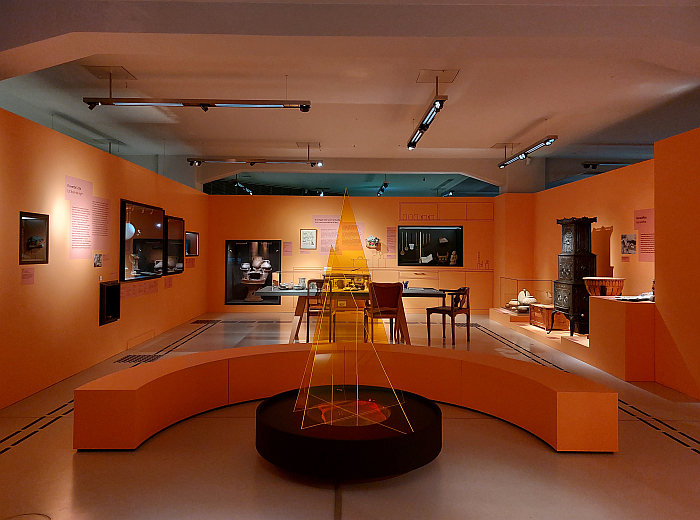
Home Sweet Home. The Archaeology of Domestic Life, SMAC – Staatliches Museum für Archäologie Chemnitz
For all that, certainly for us, there are innumerable excellent reasons for an exhibition exploring domestic arrangements and domesticity, domestic life, over that past 30,000 years, or indeed longer, for the Staatliches Museum für Archäologie Chemnitz, SMAC, there are and were three very specific reasons: on the one hand the questions regularly posed by visitors in context of the models of the earliest houses presented in the permanent exhibition as to how life was lived on a practical, daily basis in such houses, questions models alone can’t explain and explanations which a permanent exhibition can’t approach rather which must be elucidated alongside that permanent exhibition; and which is also very nice, and very apposite, reminder that a photo of an interior space in a high-gloss magazine, a catalogue or a social media feed transmits absolutely no information as to how well, bad, comfortable, et al, one lives in that space, nor as to the actual relevance, function and value of the various settings and objects, just what objects one has and how they are arranged.
On the other hand, the fact that the building that SMAC calls home was once a Schocken department store, and thus a place of trading in all manner of objects for domestic arrangements and domesticity; a location where domestic arrangements and domesticity were discussed, approached, adopted, rejected, bought and sold, where the tools and materials for domestic life were acquired, a space that was once an active contributor to the subject at hand. And thus an apposite location for deeper considerations.
And on the rare, and thus all the more valuable, third hand, by the tragic brutality of the everyday: an exhibition for autumn/winter 2023/24 on ‘Arctic Archaeology’ was in an advanced stage of planning, an exhibition for which a large number of the intended exhibits were due to be loaned from institutions in Russia, loans which in the wake of the Russian attack on, invasion of, Ukraine, ceased to be option. However, a rough sketch for an exhibition concerned with aspects of domestic arrangements and domesticity existed within the SMAC, and so was taken from the drawer where it lay and pursued while ‘Arctic Archaeology’ took its place in the drawer to await happier days.
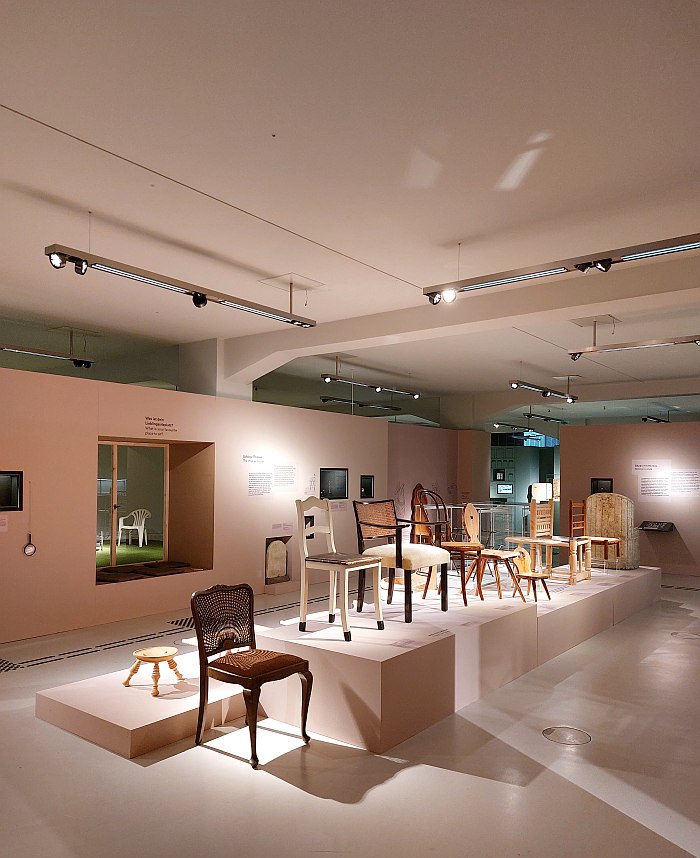
Seating and sitting in numerous contexts, as seen at Home Sweet Home. The Archaeology of Domestic Life, SMAC – Staatliches Museum für Archäologie Chemnitz
As an exhibition Home Sweet Home. The Archaeology of Domestic Life opens outwith the domestic space that is its primary focus with an exploration of the complexities of the ‘Wohnen‘ of the German title; ‘Wohnen‘ a word that as oft discussed in these dispatches cannot be directly or easily translated into English, ‘Domestic Life‘ is an excellent approximation, but can only be an approximation; much more, and as discussed from and by the Klassik Stiftung Weimar’s 2023 theme year Wohnen, Wohnen is a concept, an idea, a feeling, an emotion, a position, something that encompass a wide range of themes, including the physical act of furnishing a space; and Wohnen as both a tangible and an intangible entity Home Sweet Home seeks to introduce and approach in its opening chapter through discussing a series of fundamental questions such as, for example, “What is a house for?”, “What is a home?” or “Who is allowed a place to live?” the latter including the information that tenancy contracts have existed since the Bronze Age, information which tends to imply that a place to live has been understood as an investment, a possession, a source of income for (almost) as long as it has been whatever else it has been.
And an introduction to ‘Wohnen‘ from which you are led you indoors, and where the curators take you, essentially, on a room by room tour through domestic arrangements and domesticity, a tour which includes visits to, for example, the home office containing a sewing machine and sewing table that remind us all that homeworking is something that has been practised as paid and unpaid work for centuries, the contemporary fascination with homeworking being alone that of office workers freshly freed from the compulsion to travel to their factories; to the kitchen, a feature one learns the ancient Greeks didn’t really have, or at last didn’t have as a fixed place in the home, and which reminds one of the inter-War Functionalists’ attempts to replace the private kitchen with the communal dining room in their housing projects, and also to question if in our age of restricted living spaces kitchens are necessary; or to the lounge featuring a Roman klinē, an expression of that popular Greek and Roman argument that lying down was the better form of sitting, and which thus reminds us all of a Nanna Ditzel and her numerous post-1945 objects and projects arguing for and advancing lying down as the better form of sitting. And which reminds us specifically that we’ve still not tracked down the Viking age klinē-esque object we claim once to have come across, but still can’t locate.
Or a visit to the storeroom which aside from making reference to the shelving system developed and built some 5,000 years ago by the Neolithic tribes that occupied the contemporary Skara Brae on Orkney, also features, for example, a ceramic larnax from ca. 13th century BCE Greece, wicker baskets from ca. 1st century BCE Sachsen, the ca. 1650 painting The Pantry by Dutch artist Gerrit Dou, a tin opener from the early 20th century or a 1957 DKK H 45/63 electric fridge produced by VEB dkk Scharfenstein, and thus a direct descendent of the first European electric fridges developed in the late 1920s in the vicinity of Chemnitz by the Zschopauer Motorenwerken J.S. Rasmussen, those early pioneers of the German automotive industry and thus a further reminder not only of the importance of Sachsen in the development of the contemporary Germany, and of the contemporary Europe, but of the importance of migration to Sachsen to those developments.
And storage objects of various types which also neatly illustrate that manner in which Home Sweet Home develops its narrative and approaches its various and varied themes through the placing of same same but different objects from across all ages side by side, in dialogue and discourse with one another by way of stimulating wider ranging discussions. By way of testing the theory that “Problemerne er ikke saa nye, de er i mange Tilfælde løst før“.
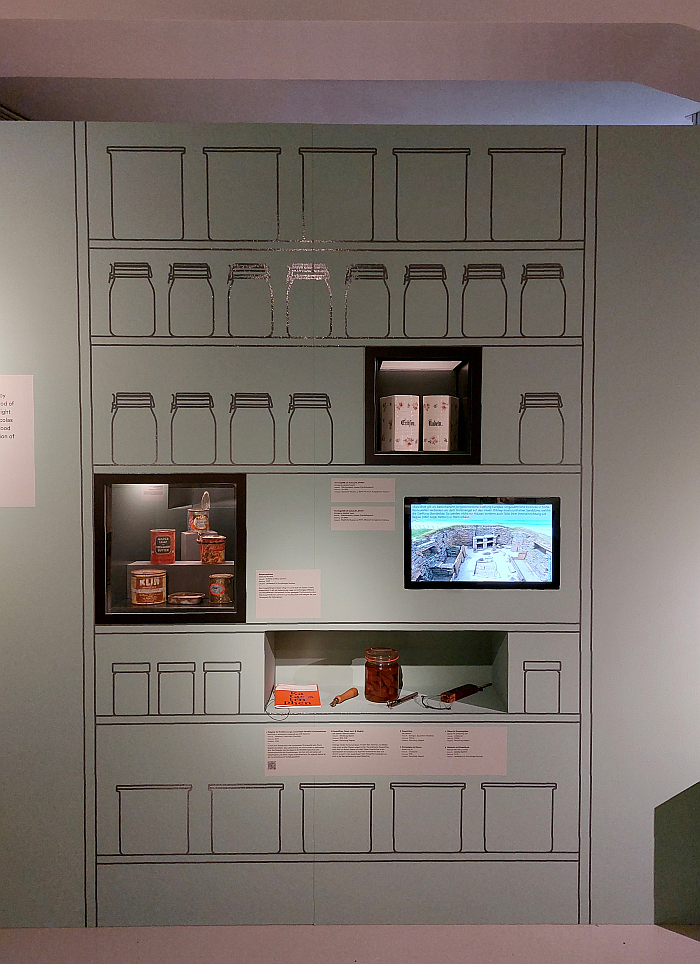
A photo of the shelving system at Skara Brae, Orkney, alongside reflections on food storage and conservation, as seen at Home Sweet Home. The Archaeology of Domestic Life, SMAC – Staatliches Museum für Archäologie Chemnitz
In, for example, the discussion on sanitation an electric washing machine stands next to hand washing utensils, thereby helping elucidate that it is often technological advances that allow us to perform exactly the same tasks in different ways; or the juxtaposition in the same chapter of developments in toilets since the 2nd century BCE, and thus a reminder that not only that which occurs within the home is a component of Wohnen but also those wider developments outwith the home in context of the infrastructure and ordering of our towns and cities as discussed, for example, in SMAC’s 2021 exhibition Die Stadt. Between Skyline and Latrine; or the presentation of a pair of late 19th/early 20th century Staffordshire porcelain dogs next to a figurine of a dog on a sofa from Fayum, Egypt, from some time around the year 0 BCE/CE which tends to imply that we’ve long had a hang to keeping models of animals as inanimate pets in our domestic spaces, if the elegance and charm of the Fayum dog in comparison to the, one fears deliberate, lack of such exhibited by the Staffordshire dogs tends to an argument that we have let out standards slip quite a lot over the centuries. A slipping of standards tending to be further underscored by the ca 0 BCE/CE Fayum figurine of two copulating dogs, almost posing, proudly, mid-romp, for the sculptor and which possesses a deliciously unassuming, infectious, humour noticeably absent in much of today’s home decoration; or a so-called insulated cooker from the early 1920s, a device for energy saving cooking which stands alongside… nothing, despite the very obvious need today for reducing our individual and collective footprints, and thus a nice reminder that the past is a treasure trove of ideas for the future. As a species we just need to develop the intelligence to appreciate that. Or ask an archaeologist to explain that to us.
And a setting of objects side by side by way of allowing differentiated insights into the development, or not, of domestic arrangements and domesticity that, certainly for us with our singular view of the world, is very neatly undertaken in context of seating objects; a chapter of Home Sweet Home which aside from explaining that sitting has kind of always been sitting, also elucidates that seating hasn’t always necessarily been seating.
A discussion on sitting and seating which features, amongst a great many other exhibits, a collection of seated idols from various locations and cultures from the 5th and 6th centuries BCE which aside from underscoring the symbolic role of seating also very much remind of the use of the kubbestol/kubbstol in Viking age amulets from Scandinavia; or the oldest known chair in Sachsen, an object found near Zwickau, dating from 1175-1300 CE, but which quite frankly doesn’t look that stable to us, although admittedly we weren’t allowed to try it out; or a Thonet plagarism from the late 19th century, a work to which we shall return in the not to distant future in context of a different exhibition, and where we will also discuss its presence in Home Sweet Home in a little more detail; or a television whose arrival in global homes marks, as the curators discuss, a moment in the development of seating and sitting culture, televisions, so the curators’ argument, becoming the primary direction giver and leading us all to sit side-by-side in our homes rather than the more common facing one another of yore. And a television which today has been replaced by the smartphone, an object which allows us to once again sit opposite one another; however, given the fact we’re all on our phones all the time, oblivious to the space around us, we might as well be in different rooms, or different buildings. Rarely has the long-distance relationship been so close at hand. And a discussion on seating and sitting that also features a chair, allegedly, built by Walter Ulbricht, the former General Secretary of the Central Committee of the Sozialistische Einheitspartei Deutschlands, SED, and thus, effectively, Prime Minister of the DDR.
No honest, a chair, allegedly by, attributed to, Walter Ulbricht.
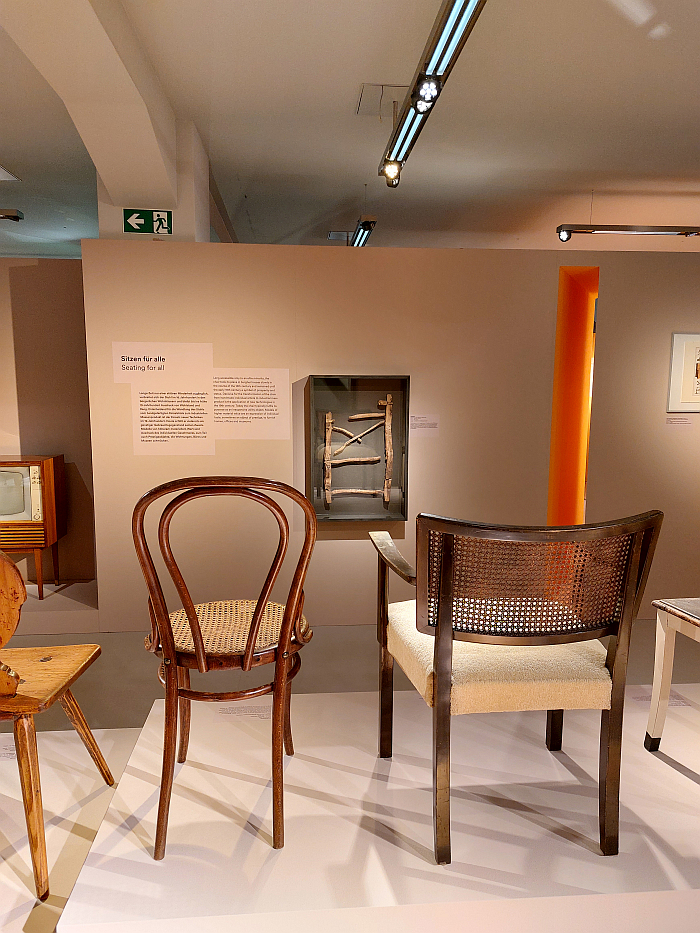
A late 19th century Thonet plagiarism and a 1936 armchair by Bruno Paul consider Sachsen’s oldest chair, as seen at Home Sweet Home. The Archaeology of Domestic Life, SMAC – Staatliches Museum für Archäologie Chemnitz
A Walter Ulbricht who, lest we forget, was a trained carpenter, and a chair, so the story, created by Ulbricht for the kitchen of his first marital home in 1920s Leipzig, whereby one presumes as Walter left the, then, chair free kitchen to go to his workshop he told his wife ‘no-one has the intention to build a chair’, and promptly came back with a chair… a little joke for all fans of DDR (hi)story there… and a chair that we’d describe as ‘nur Bretter’, ‘just planks’… a little joke for all fans of DDR furniture design (hi)story there… and a work that although otherwise unremarkable does feature front legs which curve forward rather than the more normal straight front legs with backward curving rear legs, a construction which in its improbability, and questionable appreciation of statics, tends to imply that Ulbricht’s grasp of the basics of carpentry was as good as his grasp of the basics of civics…. 🤣 Who knew you could get a whole routine from a 1920s wooden chair that may or may not be by Walter Ulbricht.
But all joking aside, and in terms of Walter Ulbricht one really shouldn’t joke, he caused far too much harm and distress and suffering and death for that; for all the forward flowing front leg appears a thoroughly useless construction principle, one presumes it was functional, one presumes that the chairs could actually be sat on. Securely and stably. And for all the unfamiliarity of the forward flowing front legs, on the one hand they are very reminiscent of the front legs of the ancient Greek Klismos, albeit in the Klismos forward flowing front legs counter-balanced by the backward flowing rear legs, and are also reminiscent of the front legs of the Thonet plagiarism alongside which it is displayed, and also the earliest Thonet 14s of which the plagiarism is such a poor imitation, an early Thonet 14 which as with the Klismos also featured backward curving rear legs to counter the forward flowing front legs: is Ulbricht’s chair, assuming it’s by him, the result of Ulbricht’s reflections on the design and construction principles of a Michael Thonet? A formal and structural development of, an escalation of, the design and construction principles of a Michael Thonet? Or those of ancient Greece? Alternatively it is a front leg also very reminiscent of that found on the ca. 1912 upholstered chair by Pavel Janák that can be enjoyed in Hej rup! The Czech Avant-Garde at the Bröhan Museum, Berlin, and which opens the tantalising possibility that Walter Ulbricht was inspired in his chair design by Czechoslovakian Cubism. We don’t believe for a minute that is true. Don’t believe for a minute a Walter Ulbricht would have been au fait with Czechoslovakian Cubism. But then you view Ulbricht’s chair and Janák’s chair and Ulbricht’s chair and Janák’s chair…
Whereby the curators also note Ulbricht may only have claimed the chair was his in order to symbolise his origins as a handworker, as an ordinary member of the working masses who had displaced the elite minority and were now in charge of the Arbeiter-und-Bauern-Staat 🙄; and thus a (potential) reminder that while chairs of power are, as with the 5th and 6th centuries BCE idols, normally thrones or other ornately constructed or visibly raised objects, depending on the context a simple wooden kitchen chair can be more powerful, and also a reminder of the very symbolic nature of not just furniture but Wohnen, that we all stage our interiors. Just some more consciously and publicly than others. And that as a species we always have.
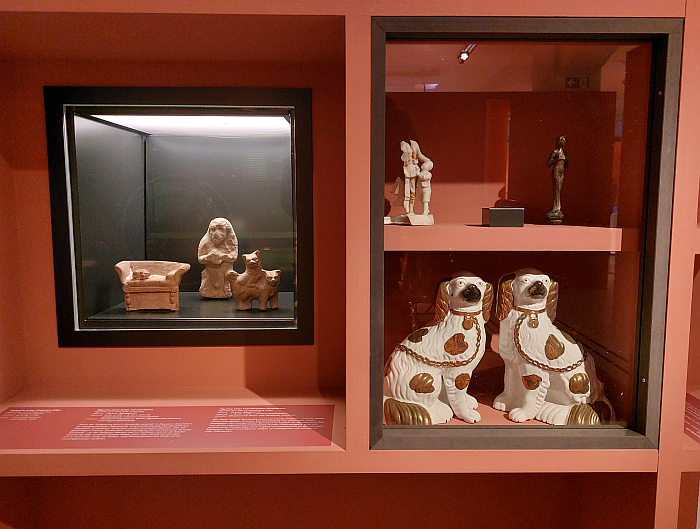
Ceramic dogs and other animals from across the centuries, as seen at Home Sweet Home. The Archaeology of Domestic Life, SMAC – Staatliches Museum für Archäologie Chemnitz
Home Sweet Home ends, if one so will, once again outwith the accommodation unit per se, with reflections on Eternal Sleep, on Wohnen after death, a nod back to the SMAC’s 2017 exhibition Tod & Ritual – Kulturen von Abschied und Erinnerung, and a reminder that across space, time and culture the afterlife is and was just another form of domestic life and thus an invitation to consider the lengths gone to to provide for a quality of life in that afterlife comparable with that in lifelife in context of the lengths we go to in lifelife; and also ends with reflections on homelessness, a discussion introduced by Fanny Allié’s 2021 light installation The Glowing Homeless, a work we last met in context of Who’s Next? Homelessness, Architecture and Cities at the Museum für Kunst und Gewerbe, Hamburg but which makes much more sense in Chemnitz, has much greater agency in Chemnitz, sited as it is just outside, on the periphery of, not just a figurative, abstract, simplified house that embodies 30,000 years of ever more comfortable, responsive, egalitarian living, of an ever sweeter home, but which as such is also an extended discussion on Wohnen tangible and intangible, and thus the access it thereby allows to all that the homeless, and precariously housed, are forced to do without beyond the obvious shelter and protection. Homelessness Bitter Homlessness. And the problems that can, does, cause beyond the physical. And a homelessness that viewing The Glowing Homeless in SMAC causes you to reflect may or may not be connected to, is connected to, the information in the first chapter that since the Bronze Age housing has been a commodity rather than being a institution freely available to all. And the question if that shouldn’t change? If after 5,000 years of ‘housing’ and ‘property’ as synonyms, it isn’t time for a change? Houses have changed, why not housing?
A question that is also a component of the final question posed by Home Sweet Home: How can/should/will we live in the future? A question posed in context of a brief review of contemporary housing statistics and modalities, and a question posed throughout Home Sweet Home; or perhaps more accurately, that question of the future of Wohnen that as Home Sweet Home neatly helps elucidate has concerned human society since its earliest days, and which Home Sweet Home also helps elucidate will never ever go away. Or at least not until human society does.
And that because, as Home Sweet Home allows one to better appreciate, not least through it long-term focus, through its exploration of Wohnen over 30,000 years rather than a quick glance over a century or two, for all that the homes of, and the expressions of domestic life by, peoples of all ilks over the past 30,000 years have been very different to ours, in many regards they were the same, similar, both in terms of objects and, and importantly, in terms of the reasons for Wohnen, the functions Wohnen was intended to serve, tangible and intangible. And those are unlikely to change. Why should they?
And through exploring Wohnen through the functions of Wohnen as much as through the objects of Wohnen, and in context of the development of human society, Home Sweet Home not only allows for differentiated insights into the (hi)story of domestic arrangements and domesticity, but also helps you focus your attention on what is truly needed, what is superfluous, what is harmful, what supportive, what is important, genuinely important, in context of domestic arrangements and domesticity.
And thus invites you to consider anew and afresh your definition of, and demands from, Wohnen.
Forces you to question your own definition of domesticity as expressed by your domestic arrangements.
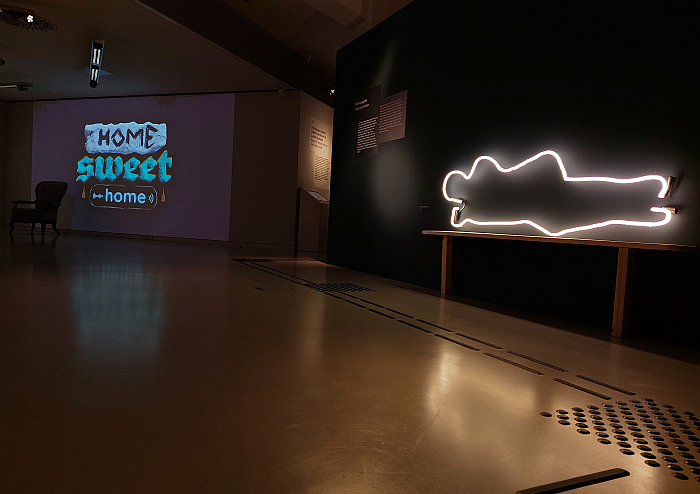
The Glowing Homeless by Fanny Allié, as seen at Home Sweet Home. The Archaeology of Domestic Life, SMAC – Staatliches Museum für Archäologie Chemnitz
A relatively sprightly exhibition, if one which despite the pace its breadth and scope forces it to take leaves you plenty of time and space to reflect on and engage with the discussions and objects, one could argue one feels very much at home in the exhibition, 🙌, Home Sweet Home very much follows in terms of structure and approach Die Stadt. Between Skyline and Latrine, which isn’t a complaint just an observation. And a connection with Die Stadt which means Home Sweet Home can be considered as much of a focussing in on one element of Die Stadt as much as it is a focussing in on the models of the earliest houses in SMAC’s permanent exhibition space that were so important in its genesis; and which as such makes very clear that a further focussing in is very much possible and desirable, the necessity of the wide discussion meaning Home Sweet Home can be but an overview of a great many inter-related and inter-twinned subjects, leaving a lot of threads to follow to a greater depth. Also on your own.
Quite aside from the very pleasing manner in which Home Sweet Home discusses domestic arrangements and domesticity as more than just interior furnishings and furniture, and aside from the very pleasing manner in which it places developments of domestic arrangements and domesticity in context of developments in human society, is the very pleasing manner in which Home Sweet Home helps reinforce that ‘artefacts’ are ‘artefacts’ regardless of their age; and as artefacts can be used to reconstruct a society or a period free of the emotions of the day and distractions of those louder members of the community, and thereby can help enable us all to approach a more probable appreciation of that society or period, regardless of whether they are artefacts from 2000 BCE, 2000 CE or any given year in between, or before 2000 BCE. And artefacts that are also a reminder of the need to stop thinking about (hi)story as facts and to think about (hi)story as that part of the journey human society is on that it has lived through and from which we can learn. And that the objects of the past are one of the keys to that learning, regardless of their age, one just has to learn to read them beyond the actual objects they are. A task in which archaeology can help us all.
Or put another way, inarguably the most pleasing aspect of Home Sweet Home is the fact that it approaches the subjects and themes of domestic arrangements and domesticity from an archaeologist’s viewpoint, with an archaeologist’s eye, not from the viewpoint, through the eyes of, a design or architecture historian: as a presentation Home Sweet Home has absolutely no interest in epochs or designers or engineers or architects or stars or positions, isn’t interested in utopic visions of the future, couldn’t care less about the form function relationship, ornamentation as crime or not, revivals, aesthetics, -isms, whatever, but rather Home Sweet Home takes a sober, objective view of the progress of domestic life over the past 30,000 years, focuses resolutely with its archaeologist’s eye on changes as described and documented by the artefacts human society has left behind on its long journey. And thereby Home Sweet Home allows one to better appreciate that for all that things have changed a lot over the centuries, they have also changed but little, and thereby to approach not only a more probable appreciation of the past 30,000 years of Wohnen, but of the past 30,000 years of human society. And also allows one to approach a better appreciation that while the problems may not be so new the contexts in which they present themselves, and in which they must be resolved, always are, and thus the challenge is less to understand the problem, we’ve done that, but understanding the problem in its context. Which we can’t have done before. But continually must. A task in which better understanding the path thus taken beyond its familiar abbreviations and approximations and objectifications can assist us greatly.
Home Sweet Home. The Archaeology of Domestic Life is scheduled to run at SMAC – Staatliches Museum für Archäologie Chemnitz, Stefan-Heym-Platz 1, 09111 Chemnitz until Sunday April 28th.
In addition a, German only, catalogue featuring numerous essays on the subjects approached in Home Sweet Home is available.
Full details, including information on the accompanying fringe programme, can be found at www.smac.sachsen.de
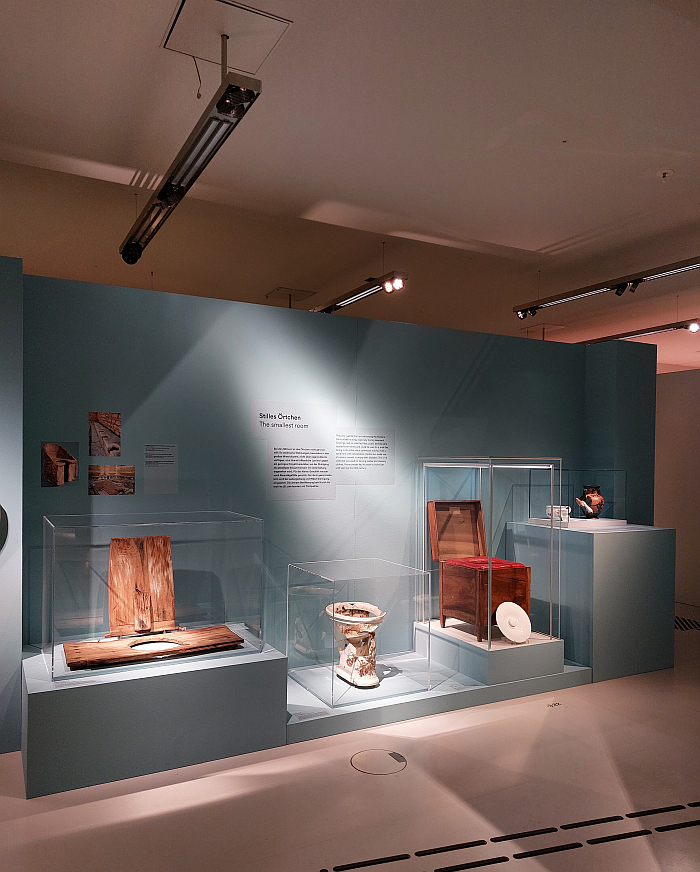
A discussion on toilets, as seen at Home Sweet Home. The Archaeology of Domestic Life, SMAC – Staatliches Museum für Archäologie Chemnitz
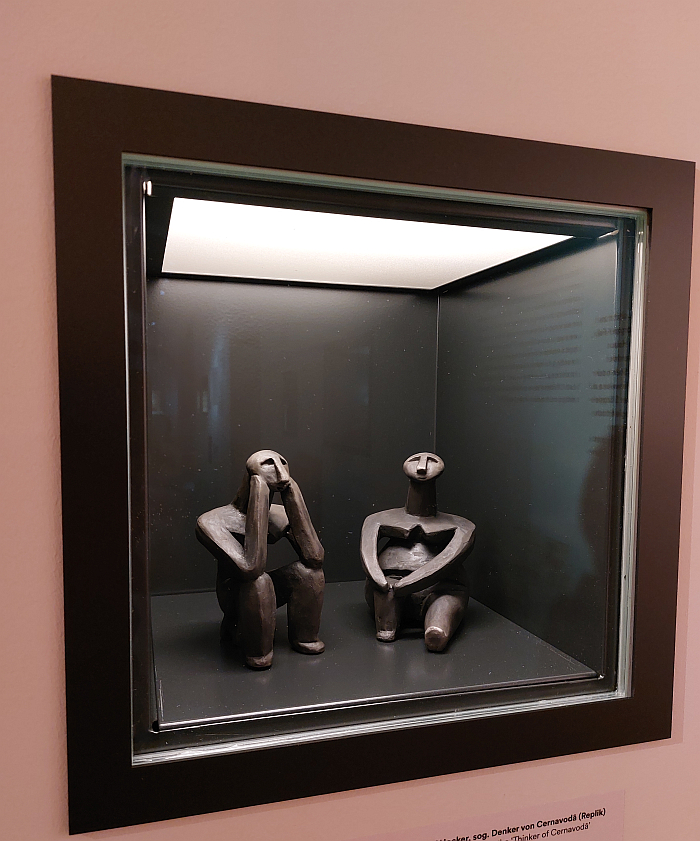
A seated couple from the 5th century BCE, only one gets a stool you’ll note, as seen at Home Sweet Home. The Archaeology of Domestic Life, SMAC – Staatliches Museum für Archäologie Chemnitz
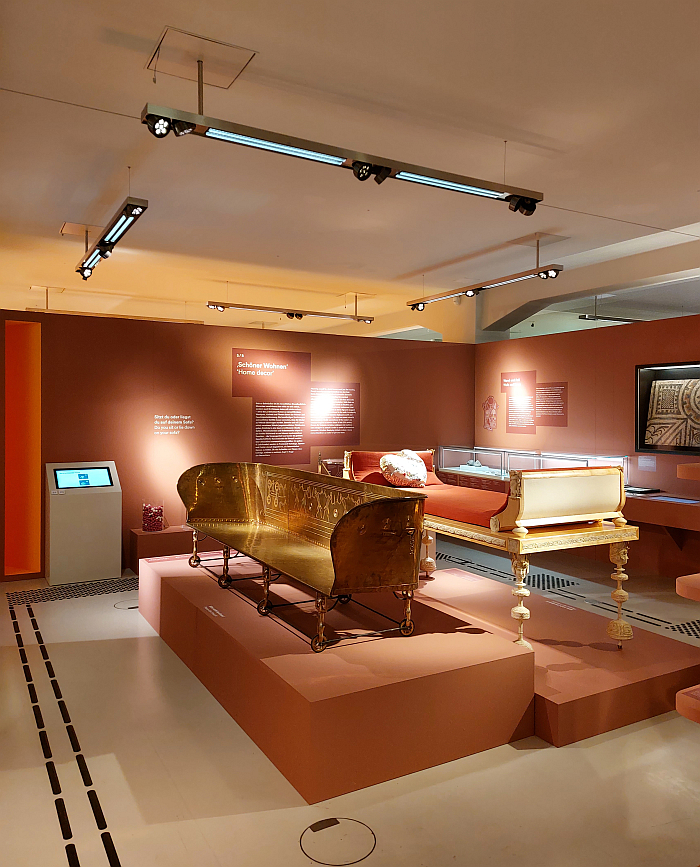
A sofa from ca 530 BCE and a Roman klinē (both reconstructions), as seen at Home Sweet Home. The Archaeology of Domestic Life, SMAC – Staatliches Museum für Archäologie Chemnitz
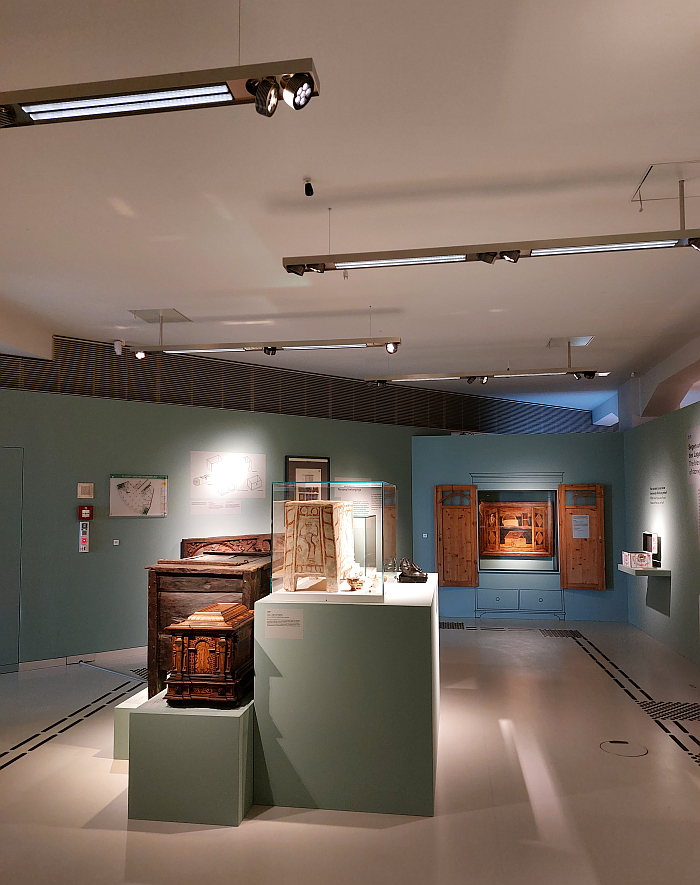
Reflections on storage, as seen at Home Sweet Home. The Archaeology of Domestic Life, SMAC – Staatliches Museum für Archäologie Chemnitz
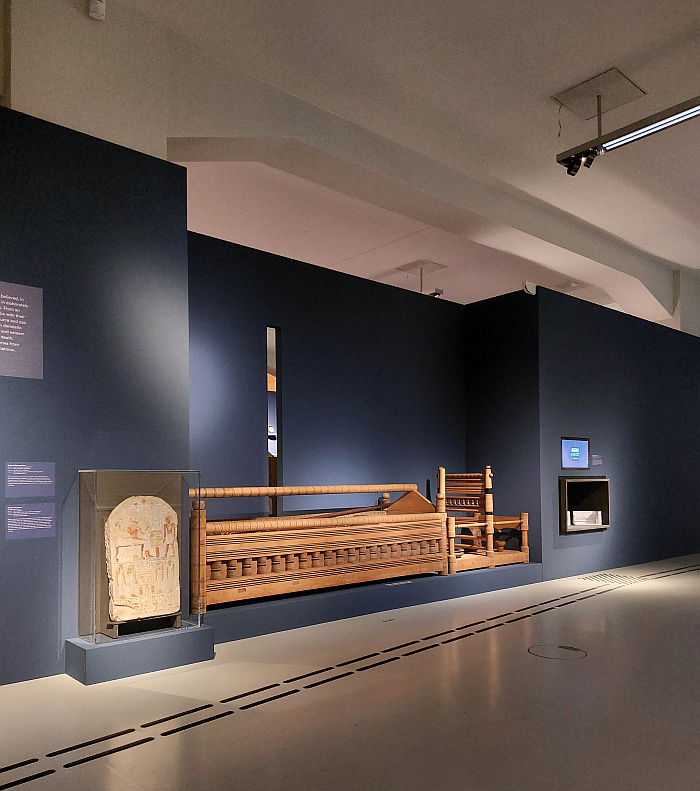
A discussion on domestic arrangements in the afterlife, as seen at Home Sweet Home. The Archaeology of Domestic Life, SMAC – Staatliches Museum für Archäologie Chemnitz
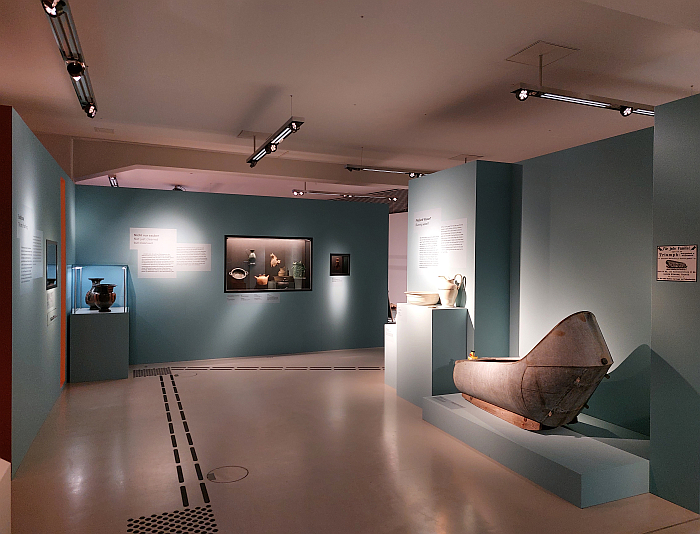
A discussion on bathing, as seen at Home Sweet Home. The Archaeology of Domestic Life, SMAC – Staatliches Museum für Archäologie Chemnitz
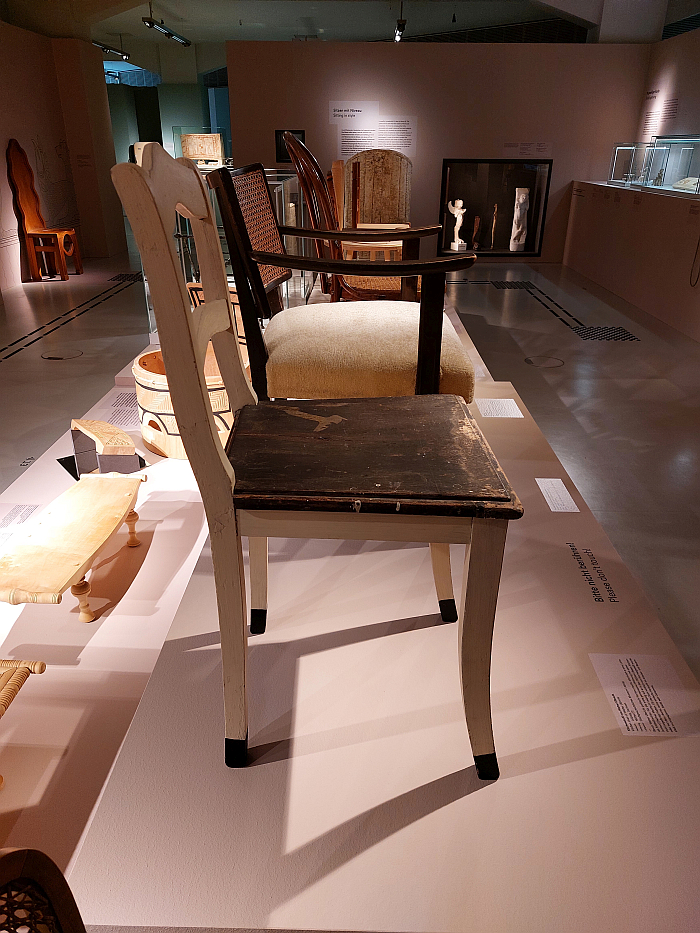
A 1920s wooden chair attributed to Walter Ulbricht with a fascinating leg design, as seen at Home Sweet Home. The Archaeology of Domestic Life, SMAC – Staatliches Museum für Archäologie Chemnitz
1. Kaare Klint, Undervisningen i Møbeltegning ved Kunstakademiet, Arkitekten månedshæfte, October 1930, page 203
Tagged with: Archaeology, chemnitz, Home Sweet Home, smac, Staatliches Museum für Archäologie Chemnitz, The Archaeology of Domestic Life, Wohnen